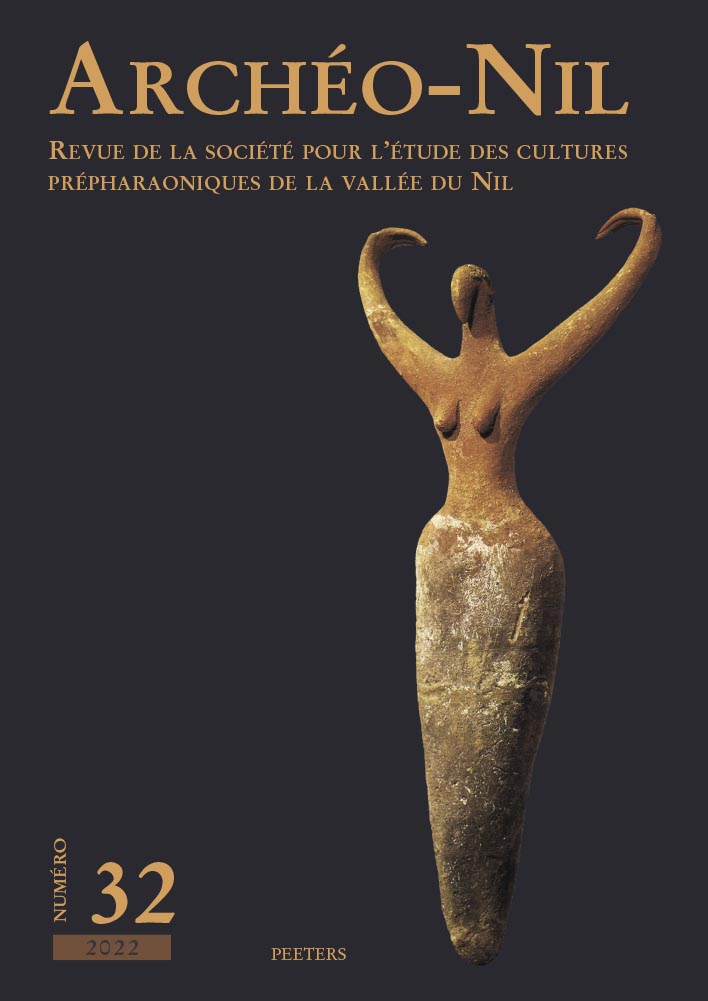 previous article in this issue previous article in this issue | next article in this issue  |

Preview first page |
Document Details : Title: Forming the Herd Subtitle: A Re-examination of Predynastic Bovine Figurines from Settlement Contexts Author(s): BRICE, Elizabeth Journal: Archéo-Nil Volume: 31 Date: 2021 Pages: 83-110 DOI: 10.2143/ANI.31.0.3291287 Abstract : Since the early 20th century, bovine figurines have been excavated from Upper Egyptian Predynastic settlements and cemeteries dating between Naqada IA–IIC/D (ca. 3800–3325 BCE). Though still rare finds for this period, they are currently the most commonly identified zoomorphic figurine subject, far outnumbering other wild and domestic animals. As a result of their greater quantity, bovine figurines have been the subject of numerous iconographic and contextual studies which have proposed that these objects were produced for religious rituals, ex-votos, and proxies of the real animal. Using bovine figurines from three settlements with similar features and archaeological contexts, namely el-Mahâsna, Zawaydah, and Armant, this paper provides another interpretation which places the evidence within an economic context, where the figurine acts as a record of the negotiations and exchanges of cattle. The analysis draws upon the visual and material attributes of the figurines within their broader archaeological context to compare with a hypothesis that was proposed by Wengrow. The multifaceted value of cattle as producers of primary and secondary products, and indexes of wealth made them a significant animal to own; thus, individuals may have documented the negotiation for live cattle and carcasses using bovine figurines. Depuis le début du xxe siècle, des figurines bovines ont été découvertes au cours des fouilles d’habitats et de cimetières prédynastiques de Haute Égypte datant de la période Naqada IA-IIC/D (environ 3800-3325 avant notre ère). Bien que très rares pour cette période, les bovidés sont dans l’état actuel de la documentation les animaux les plus représentés parmi les figurines zoomorphes, dépassant de loin les autres animaux sauvages et domestiques. En raison du nombre d’exemplaires mis au jour, les figurines de bovidés ont fait l’objet de nombreuses études iconographiques et contextuelles qui proposent que ces objets aient été produits pour des rituels religieux, comme ex-voto et comme substituts d’animaux réels. En utilisant les figurines de bovidés provenant de trois établissements présentant des caractéristiques et des contextes archéologiques similaires, à savoir el-Mahâsna, Zawaydah et Armant, cet article propose une autre interprétation qui situe la documentation dans un contexte économique, où la figurine agit comme un enregistrement des négociations et des échanges de bétail. L’analyse s’appuie sur les attributs visuels et matériels des figurines dans un contexte archéologique plus large envisagé à partir de l’hypothèse proposée par Wengrow. La valeur multiforme du bétail, en tant que producteur de produits primaires et secondaires, et en tant qu’indice de richesse, en faisait un animal important à posséder; ainsi, les individus ont pu documenter la négociation de bétail vivant et de carcasses en utilisant des figurines de bovidés. |
|


